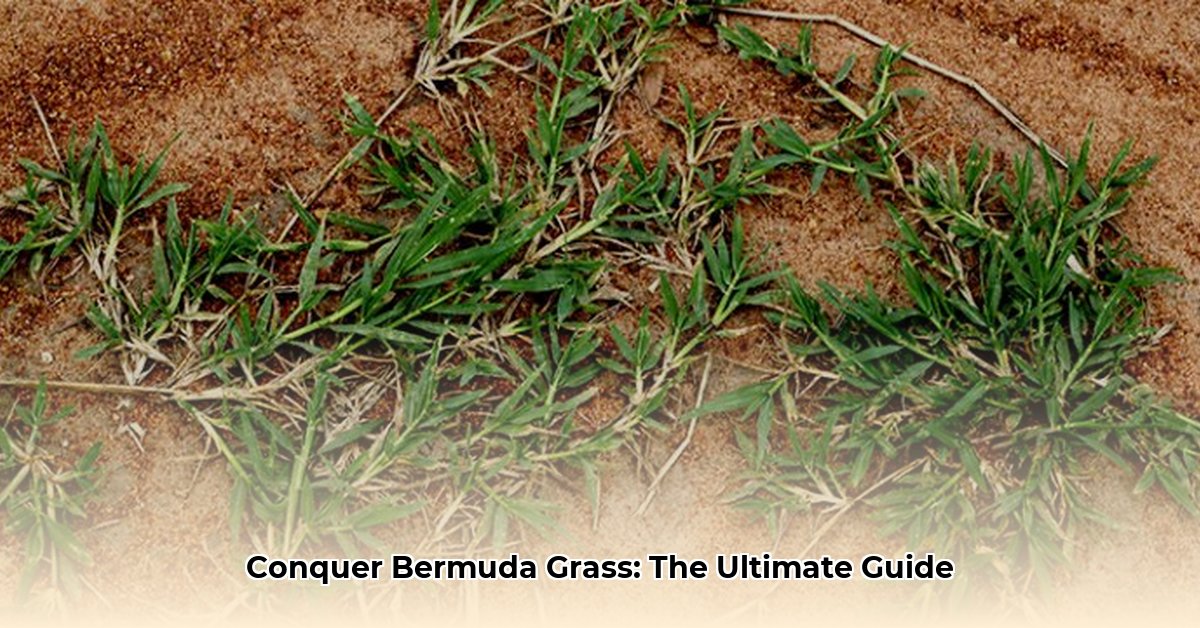Bermuda grass, the tenacious lawn invader, can be a frustrating foe for any gardener. This guide provides a comprehensive strategy to identify, eliminate, and prevent Bermuda grass from reclaiming your outdoor space.
Identifying the Enemy: Bermuda Grass Up Close
Before waging war, ensure you’re facing the right opponent. Bermuda grass (Cynodon dactylon) is identifiable by:
- Color: A subdued grayish-green, sometimes with a bluish tint, rather than a vibrant green.
- Texture: Fine-textured blades with slightly rough edges, almost sandpaper-like.
- Seed Head: Resembles a miniature hand with 3-6 finger-like projections.
- Growth Habit: Aggressive spreading, forming dense mats via above-ground stolons and below-ground rhizomes. These rhizomes are the key to its persistence, as even small fragments can regenerate.
Look-Alikes: Avoiding Mistaken Identity
Don’t confuse Bermuda grass with similar-looking weeds like crabgrass. Crabgrass typically has wider, coarser blades, a lighter yellowish-green color, and a more sprawling growth habit. Its seed head is a branched, irregular structure, unlike Bermuda’s distinct fingers. Compare your suspect grass with reliable images online or consult your local agricultural extension office for confirmation. Accurate identification is crucial for effective control. Ongoing research suggests that even the timing of treatments can be affected by specific grass types.
Eradication Strategies: Five Proven Methods
Eliminating Bermuda grass requires a multi-pronged approach. Choose the method(s) best suited to your situation and be prepared for a persistent effort.
Organic Approaches
1. Solarization: Harnessing the Sun’s Power
Cover the affected area with clear plastic sheeting for 4-6 weeks during the hottest part of the year. The trapped heat raises soil temperature, effectively baking the grass and its root system. Monitor soil temperature, aiming for 120-140°F (49-60°C) for optimal results.
- Pros: Environmentally friendly, inexpensive.
- Cons: Time-consuming, requires intense sunlight, unsuitable for cooler climates.
2. Smothering with Mulch: Depriving Sunlight
Cover the area with landscape fabric, then a thick layer (8-10 inches) of organic mulch like wood chips or straw. This blocks sunlight, weakening and eventually killing the grass.
- Pros: Simple, relatively low-cost, chemical-free.
- Cons: May not kill the deepest roots, requires maintenance and mulch replenishment, slow process.
Chemical Solutions
3. Selective Herbicides: Precision Targeting
These herbicides target Bermuda grass while (ideally) sparing other plants. Carefully research and select a product compatible with your desired vegetation. Always follow product instructions meticulously and consider the potential environmental impact.
- Pros: Effective, targeted control.
- Cons: May require repeat applications, some environmental risk.
4. Non-Selective Herbicides: The “Nuclear Option”
These powerful herbicides kill all vegetation in the treated area. Exercise extreme caution, including protective gear and isolating the treatment zone, to avoid collateral damage. Glyphosate (e.g., Roundup) is a common example.
- Pros: Highly effective at eliminating all plants.
- Cons: Kills all vegetation, requires careful application and safety measures.
5. Horticultural Vinegar: A Natural Herbicide
Horticultural vinegar (20% acetic acid or higher – household vinegar isn’t strong enough) acts as a natural herbicide. Repeated applications may be necessary, and adding dish soap can improve adherence to grass blades.
- Pros: Natural, relatively inexpensive.
- Cons: Multiple applications likely, effectiveness may vary.
Pre-Treatment Preparations
Before starting any removal method:
- Clear the area of debris.
- Test your soil to understand its conditions.
- Consider slightly raising your mowing height for a week or two before treatment to potentially weaken the Bermuda grass.
Prevention: Keeping Bermuda Grass at Bay
After eradication, focus on prevention to avoid a resurgence.
Pre-Emergent Herbicides: Building a Barrier
Apply pre-emergent herbicides in spring and/or fall to prevent Bermuda grass seeds from germinating. Timing may vary regionally, so consult local resources.
Cultivating a Resilient Lawn: Nature’s Defense
A healthy lawn is your best defense. Implement these practices:
- Proper Mowing: Avoid scalping; maintain a height appropriate for your grass type to encourage deep root growth.
- Wise Watering: Water deeply and less frequently to promote strong roots.
- Effective Fertilization: Use a soil test to determine the right fertilizer type and amount.
- Aeration and Overseeding: Improve soil health and turf density to outcompete weeds.
Long-Term Management Considerations
- Identify your turf type for tailored care.
- Maintain soil health through testing and amendments.
- Monitor regularly for early signs of Bermuda grass.
Comparing Removal Methods
| Method | Pros | Cons | Cost | Time |
|---|---|---|---|---|
| Solarization | Environmentally friendly, Cost-effective | Time-consuming, Requires intense sunlight | Low | High |
| Mulching | Simple, Relatively inexpensive, Suppresses other weeds | Slow, May not kill deep roots completely | Moderate | Moderate |
| Selective Herbicide | Effective, Targeted control, Minimizes damage to desired plants | May require repeat applications, Potential environmental impact | Moderate | Low-Moderate |
| Non-Selective Herbicide | Highly effective | Kills all vegetation, Requires careful application | Moderate | Low |
| Horticultural Vinegar | Natural, Relatively inexpensive | May require multiple applications, Effectiveness can vary | Low | Moderate |
| Manual Removal | No chemicals, precise control | Extremely labor-intensive, only practical for small patches | Low | High |
This information is for general knowledge and informational purposes only. Consult local experts for tailored advice and regional considerations. Ongoing research continues to explore more effective, eco-friendly weed management techniques, so stay informed about the latest developments.
- Ceramic Kitchen Wall Tiles: Style and Protection for Your Walls - December 17, 2025
- Kitchen tiling wall: Elevate your kitchen with stylish wall tiles - December 16, 2025
- Gray Kitchen Backsplash Tile: Ideas for a Stylish Upgrade - December 14, 2025









